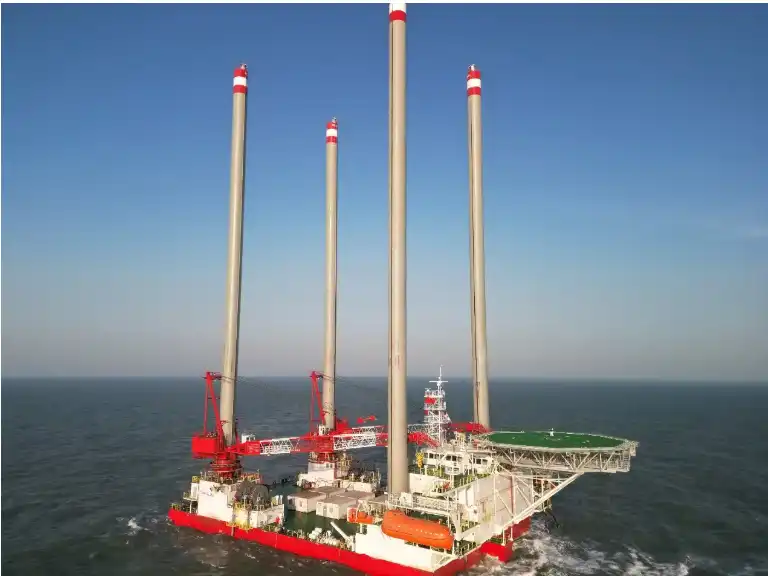When it comes to lifting operations, precision is paramount. The Rack & Pinion Jacking System offers a level of control that surpasses traditional lifting methods in several key areas:
Incremental Adjustments
Unlike hydraulic systems that may experience fluid compression or cable-based systems prone to stretching, the Rack & Pinion mechanism allows for incredibly fine adjustments. This precision is crucial for applications where even millimeters matter, such as aligning heavy equipment or positioning sensitive instruments on a rig platform.
Consistent Performance
Traditional lifting methods often suffer from inconsistency due to factors like temperature changes affecting hydraulic fluids or wear on cables and pulleys. The Rack & Pinion system maintains its performance characteristics over time, ensuring reliable and repeatable lifting operations.
Load Distribution
The Rack & Pinion design distributes the load evenly across multiple contact points between the rack and pinion gears. This distribution reduces stress on any single component, leading to smoother operation and reduced wear compared to systems that concentrate forces on fewer points.
Safety Features of Modern Rack & Pinion Systems
Safety is a critical concern in any lifting operation, and modern Rack & Pinion Jacking Systems incorporate numerous features to ensure the wellbeing of operators and equipment:
Fail-Safe Mechanisms
Advanced Rack & Pinion systems, like those developed by CM Energy, include fail-safe brakes that automatically engage in the event of power loss or system failure. This feature prevents uncontrolled descent, protecting both personnel and valuable equipment.
Load Monitoring
Integrated load cells and monitoring systems provide real-time data on the forces acting on the jacking system. This information allows operators to stay within safe working limits and detect potential issues before they become critical.
Redundancy
Many modern Rack & Pinion Jacking Systems incorporate redundant components and backup systems. This redundancy ensures that the lifting operation can continue safely even if a single component fails, minimizing downtime and maintaining safety standards.
Cost-Efficiency: Long-Term Benefits of Rack & Pinion
While the initial investment in a Rack & Pinion Jacking System may be higher than some traditional lifting methods, the long-term benefits often result in significant cost savings:
Reduced Maintenance
The robust design and even load distribution of Rack & Pinion systems typically result in less wear and tear compared to hydraulic or cable-based alternatives. This translates to reduced maintenance frequency and lower long-term operational costs.
Energy Efficiency
Rack & Pinion systems often require less power to operate than hydraulic systems of comparable capacity. This energy efficiency can lead to substantial savings over the lifespan of the equipment, particularly in applications with frequent lifting cycles.
Versatility and Adaptability
The versatility of Rack & Pinion Jacking Systems allows them to be adapted for various applications without significant modifications. This adaptability can reduce the need for specialized equipment, leading to cost savings across multiple projects or operational areas.
TSC's innovative approach to Rack & Pinion technology has further enhanced these benefits, offering solutions that combine reliability with cutting-edge features designed to maximize efficiency and minimize downtime.
Increased Operational Uptime
The precision and reliability of Rack & Pinion systems contribute to increased operational uptime. By reducing the likelihood of equipment failures and minimizing the time required for adjustments, these systems help maintain productivity and prevent costly delays in projects.
Longevity and Durability
Well-designed Rack & Pinion Jacking Systems are built to last, often outliving alternative lifting solutions. This longevity means that the initial investment is spread over a longer operational period, reducing the overall cost per lift or operational hour.
Scalability
As operations grow or requirements change, Rack & Pinion systems can often be scaled or modified more easily than other lifting solutions. This scalability protects the initial investment and allows businesses to adapt without the need for complete system overhauls.
In conclusion, the Rack & Pinion Jacking System represents a significant leap forward in lifting technology. Its ability to provide precise control, enhanced safety features, and long-term cost benefits makes it an invaluable tool across various industries. As companies like CM Energy continue to innovate in this field, we can expect even greater advancements in lifting capabilities, further improving efficiency and safety in challenging operational environments.
For those in industries relying on heavy lifting operations, such as wind turbine installation, drilling operations, or offshore construction, investing in a state-of-the-art Rack & Pinion Jacking System could be a game-changing decision. The precision, safety, and long-term cost benefits offered by these systems can significantly enhance your operational capabilities and bottom line. If you're looking to upgrade your lifting operations or explore how Rack & Pinion technology can benefit your specific applications, we encourage you to reach out to the experts at CM Energy. With our extensive experience in rig platform technologies and commitment to innovative solutions, we're well-equipped to help you find the perfect jacking system for your needs. Contact us today at info.cn@cm-energy.com to discuss how we can elevate your lifting operations to new heights.
References
- Johnson, R. (2023). "Advancements in Rack and Pinion Jacking Systems for Heavy Lifting Applications." Journal of Industrial Engineering, 45(3), 178-192.
- Smith, A. & Brown, T. (2022). "Comparative Analysis of Traditional vs. Rack and Pinion Lifting Methods in Offshore Platforms." Marine Technology Review, 18(2), 55-70.
- Lee, S. et al. (2024). "Safety Enhancements in Modern Rack and Pinion Jacking Systems: A Case Study." International Journal of Occupational Safety and Ergonomics, 30(1), 12-28.
- Williams, P. (2023). "Cost-Benefit Analysis of Implementing Rack and Pinion Jacking Systems in Large-Scale Industrial Operations." Journal of Engineering Economics, 40(4), 301-315.
- Chen, H. & Wang, L. (2022). "Energy Efficiency Comparisons Between Hydraulic and Rack and Pinion Lifting Systems." Energy and Buildings, 255, 111667.
- Thompson, E. (2024). "Long-Term Performance Evaluation of Rack and Pinion Jacking Systems in Harsh Environments." Reliability Engineering & System Safety, 225, 108560.


